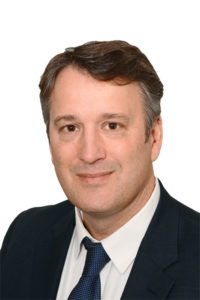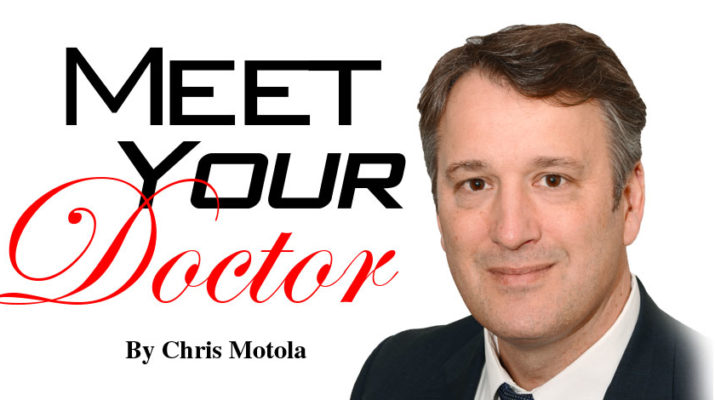New director of the Flaum Eye Institute talks about cutting edge research done locally, wants to make eye institute top destination for those who need eye care
By Chris Motola

Q: Tell us a little bit about the Flaum Eye Institute.
A: When [former director] Steve Feldon got here in 2001, he started a more academic eye department. Then, by 2005, it was officially named the Flaum Eye Institute, which brought together both researchers and clinicians to drive the science and clinical work forward and manage very specialized cases. That’s what we’ve been doing for the last several years. So, when I took over [on Dec. 16], I wanted to create a space where we could take care of everyone without having to refer them to the Cleveland Clinic or Johns Hopkins. So that’s my major goal right now — recruiting those super-subspecialists on ocular oncology, ocular genetics and other very distinct diseases so we can become not just a destination for Upstate New York, but the whole nation.
Q: What kinds of conditions are we talking about?
A: We deal with everything here from eye glasses and contact lens to extremely difficult ocular injuries like retinal detachment. Retina surgery, glaucoma, pediatrics, cataract surgery, we have the whole spectrum of services.
Q: What impact has the pandemic had on the Flaum Eye Institute, particularly the restrictions on elective procedures?
A: Depending on the subspecialty, some things like cataract surgery are considered more elective while things like glaucoma or retina surgery are considered more emergent. But overall our volume is down quite a bit. Now that they’ve announced the reopening of elective surgery and exams, we’ve been ramping up slowly and have developed a plan to address the COVID-necessitated restrictions of distancing and taking care of not just patient-distancing, but staff as well. We created what we call a “parking lot waiting system.”
Q: Can you elaborate more on this “parking lot waiting system”?
A: Much like what you’ve seen in many retail places these days, they’ll call a number to check from, they’ll be screened and check in from their car, and be called up when their appointment is ready. That limits the number of people in the eye wing of the hospital. For people who take a taxi or get dropped off, there’s enough space for them to wait safely in the waiting room. Everybody’s offered a mask if they don’t have one. Staff wears masks as well as eye-shields or goggles. One patient per room, and that’s their room until they’re done. I don’t know how familiar you are with ophthalmology, but there’s a lot of testing involved. So normally we would bring a patient in for testing, then send them back to the waiting room; there was a lot of shuffling around involved. So, we stopped all that. When a patient is completely done with their room, that room is completely wiped down and sanitized. We have all the precautions possible that we could have in place to protect or patients, physicians and staff.
Q: Have these measures helped you identify any processes that you’d want to change permanently?
A: It’s really interesting. With all the bad stuff that’s going on, we’re still trying to learn what we can from it. And what we’re learning is how to be really efficient and understand what we really need to run a practice. We were working on that before this started, but it really forces your hand. How many staff and people do you need? How are you using the patients’ time and the physicians’ time? So, usually a physician will schedule a patient based on what they need and, as you know when you go to the doctor, it leaves the patient waiting around a lot. So, when you’re scheduling around the patient, they’re actually a lot happier. They come in, they go home and things are a lot more efficient. We never thought it could be done, that we could see as many patients as we could the other way, but it looks like if you have proper things in place, you still may be able to do this. What could come out of this is all those jokes about waiting for your doctor may die away.
Q: You’re doing some work with genetic therapies for ocular issues. Can you tell us a little about that?
A: We do a number of things. We do clinical trials where we’re testing various drugs and procedures. And then we’re imagining studies where we look at the cellular level of how diseases change the eye, and what can be done. The earlier you can detect a change and the earlier you intervene, the more vision you’re going to be able to save. So being able to image at the cellular level, you can see how the disease effects these things and how drugs affect the process. We’re also doing stem cell transplantation. Not in humans right now, but it’s experimental in animals, where we’re trying to use stem cells to replenish damaged retinas. We’re also using optogenetics, which is transforming cells in the retina that don’t normally capture light by injecting certain genes into the eye into light-sensing cells. When you have degenerative eye disease, you lose your photo-receptive cells, but you’re left with other cells that are still connected to your optic nerve and your brain. By injecting a vector into the eye that would imprint this new machinery into the cells that are already there, you can turn a ganglion cell into a photo-receptor cell. So those are some of the things we’re still working on. It’s still experimental.
Q: On the more mundane side, are there any interesting advances in vision correction coming down the pipe?
A: Yeah, we have our refractive center that Scott MacRae runs. He does custom refractive surgery. He’s one of the leaders in the nation as far as using a laser to change the shape of the cornea to create better vision. In the past you’d call it Lasik, but there are now all kinds of different laser procedures a physician can use to help a patient see better. We’re looking at an experimental technology where we’re using a laser to try to change the shape of the cornea that Krystel Huxlin is working on. This is where you selectively burn spots within the corneal tissue with small, microbursts of energy. So instead of shaving the surface of the cornea, you’re going inside the tissue itself and creating little spots that change the shape of the cornea.
Lifelines
Name: David A. DiLoreto, M.D., Ph.D.
Hometown: Tacoma, Washington
Position: Chairman of ophthalmology at the University of Rochester School of Medicine and Dentistry; director of the Flaum Eye Institute
Education: University of Rochester School of Medicine (Ph.D. and M.D.)
Training: Residency at University of Southern California School of Medicine; internship Highland Hospital of Rochester; fellowship at Wilmer Eye Institute — Johns Hopkins Hospital
Organizations: American Academy of Ophthalmology; American Society of Retina Specialists; New York Ophthalmology Society
Family: Wife (Zoe Williams, neuro-ophthalmologist at Flaum Eye Institute); two children
Hobbies: Tennis

